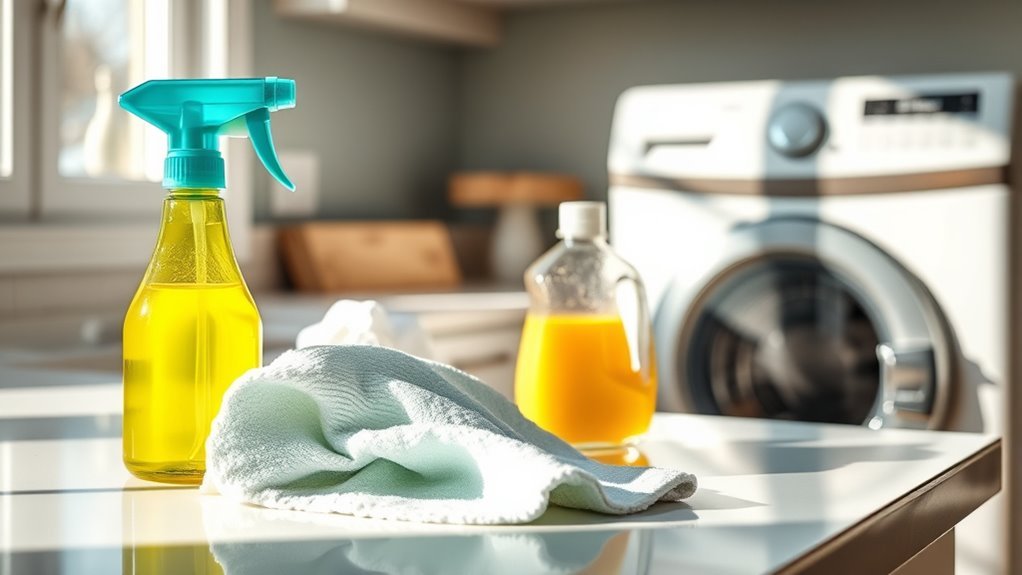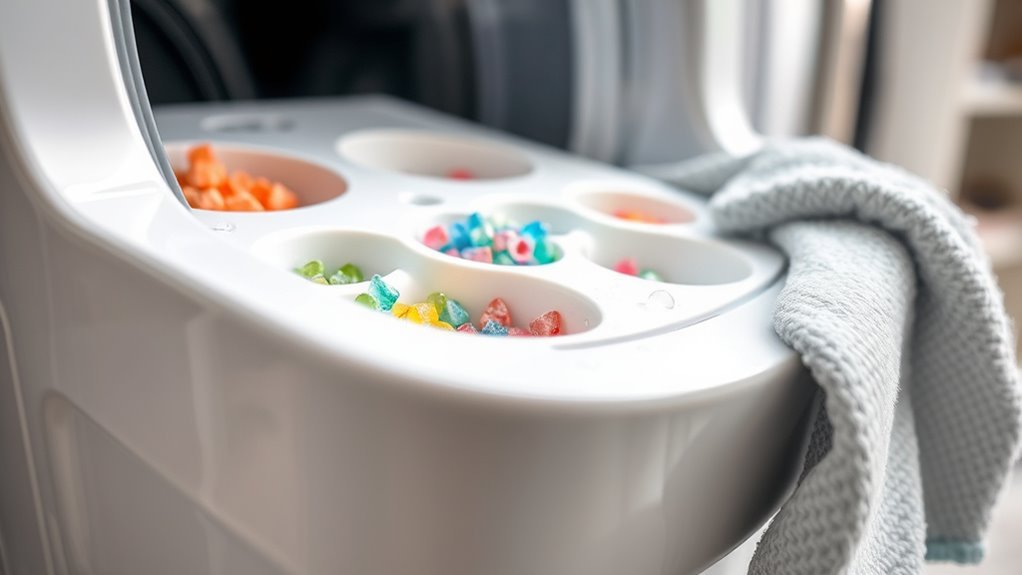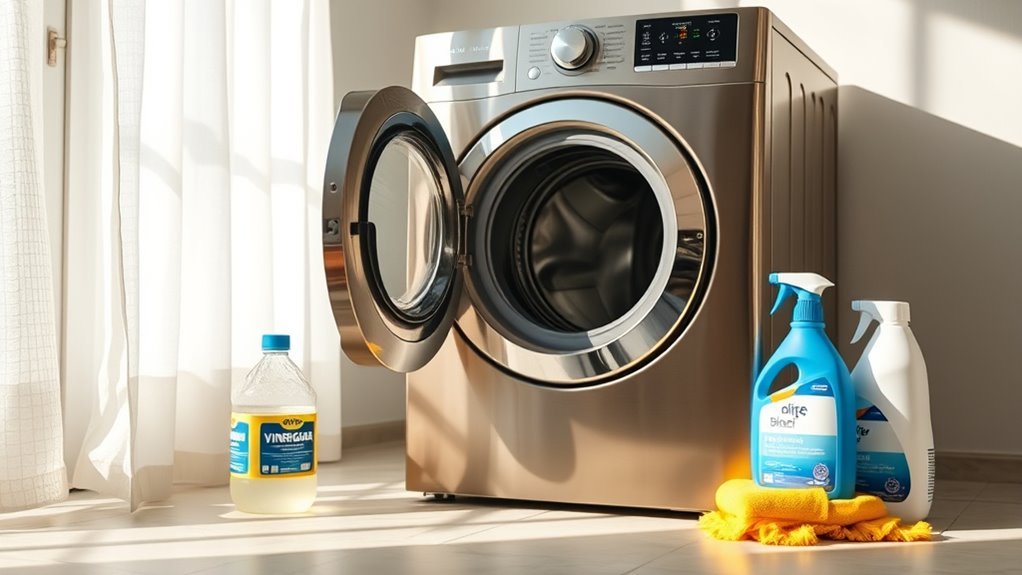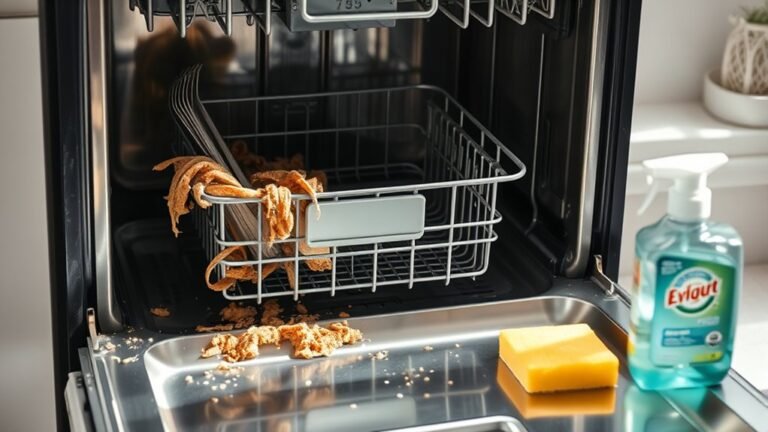Weekly Cleaning Routine for Washer
To keep your washer running smoothly, gather essential supplies like microfiber cloths, vinegar, and baking soda. Wipe down the exterior weekly and clean the detergent dispenser by soaking and scrubbing it. Run a hot water cycle with vinegar to dissolve buildup, then scrub the drum and door seal. Regularly clean the lint filter and check the drain pump. Always leave the door open after use to air out moisture. There are more tips to help you maintain a fresh, efficient washer.
Gather Cleaning Supplies

Before you begin cleaning your washer, you’ll need to gather a few essential supplies. Having the right cleaning tools on hand lets you move through your routine quickly and efficiently, freeing up your time for what really matters. Start with a microfiber cloth or sponge—these are gentle yet effective for scrubbing without damage. Grab a spray bottle filled with a mix of water and white vinegar; it’s a natural cleanser that cuts through residue. You’ll also want some baking soda to tackle stubborn grime inside the drum. Don’t forget rubber gloves to protect your hands and a soft-bristle brush to reach tight spots. With these essential supplies ready, you’re set to keep your washer fresh and running smoothly, giving you the freedom to live life without laundry worries.
Wipe Down the Exterior
With your cleaning supplies ready, you can move on to wiping down the exterior of your washer. Depending on the exterior materials—whether stainless steel, plastic, or painted surfaces—you’ll want to choose a gentle cleaner that won’t damage the finish. A soft cloth or microfiber towel works best for removing dust, smudges, and detergent spills without scratching. Maintaining a consistent cleaning frequency, ideally once a week, prevents buildup and keeps your washer looking fresh and inviting. This small effort frees you from stubborn grime and helps your machine last longer. By regularly caring for the exterior, you guarantee your laundry space stays neat and your washer stays in peak condition, giving you more freedom to enjoy life instead of worrying about maintenance.
Clean the Detergent Dispenser

To keep your washer running smoothly, you’ll want to clean the detergent dispenser regularly. Start by removing it and soaking it in warm water to loosen any buildup. Then, scrub it with a brush and make sure it’s completely dry before putting it back in place.
Remove and Soak
Start by removing the detergent dispenser from your washer to give it a thorough clean. This simple act frees you from buildup that limits your washer’s efficiency. Next, prepare a soaking solution that tackles grime without harsh chemicals, preserving your freedom to choose eco-friendly options. Immerse the dispenser fully, allowing the soak duration to break down residue effortlessly.
- Use warm water mixed with white vinegar or baking soda as your soaking solution.
- Let the dispenser soak for at least 30 minutes to loosen stubborn deposits.
- After soaking, rinse it under running water to wash away loosened dirt.
Scrub With Brush
Once the detergent dispenser has soaked and loosened the grime, it’s time to tackle the buildup still clinging to it. Grab a brush that suits the task—soft-bristle brushes work well to avoid damage, while a toothbrush can reach tight corners. Mastering scrub techniques lets you free the dispenser from stubborn residue quickly, preventing future clogs and odors. Focus on all compartments and crevices, applying firm but gentle pressure to lift away buildup. This hands-on step empowers you to maintain your washer’s efficiency without relying on harsh chemicals or costly repairs. By choosing the right brush types and scrubbing smartly, you reclaim control over your appliance’s cleanliness, ensuring it’s ready for your next laundry load with minimal effort.
Dry Before Reinstalling
After thoroughly scrubbing the detergent dispenser, make sure you dry it completely before putting it back in place. Proper drying techniques are essential for moisture prevention, which keeps mold and mildew from forming, giving you more freedom from unwanted odors and maintenance.
Here’s how to dry your dispenser effectively:
- Use a clean microfiber cloth to absorb all visible water.
- Let the dispenser air dry in a warm, well-ventilated spot for at least 15 minutes.
- For stubborn moisture, use a hairdryer on a low, cool setting to speed up drying.
Run a Hot Water Cycle With Vinegar

To keep your washer fresh and free from buildup, run a hot water cycle with vinegar once a week. Vinegar naturally breaks down soap scum, mineral deposits, and odors without harsh chemicals. Simply add two cups of white vinegar to the drum, select the hottest water setting, and start the cycle.
Benefits of Vinegar Cleaning
Although you might not realize it, running a hot water cycle with vinegar can greatly improve your washer’s performance. Vinegar benefits go beyond just cleaning; it’s a powerful natural cleaner that frees your machine from buildup without harsh chemicals. When you use vinegar, you’re choosing a simple, eco-friendly way to maintain your washer’s efficiency and extend its life.
Here’s what happens when you clean with vinegar:
- Mineral deposits and soap scum dissolve, preventing clogs and odors.
- Mold and mildew are naturally eliminated, keeping your washer fresh.
- Residue that dulls fabrics and affects wash quality is removed, giving your clothes new life.
Using vinegar lets you keep your washer spotless and working smoothly, so you enjoy freedom from costly repairs and smelly laundry.
How to Run Cycle
Running one hot water cycle with vinegar is a simple yet effective way to keep your washer in top shape. Just pour two cups of white vinegar into the detergent dispenser, select the hottest and longest cycle, and let it run empty. This routine helps dissolve soap scum, mold, and odors that build up over time. To maintain freedom from stubborn odors and buildup, stick to a cycle frequency of once a week. It’s an easy maintenance tip that saves you from costly repairs and keeps your laundry fresh. By committing to this quick ritual, you’re ensuring your washer runs efficiently without hassle. With just this small step, you’re free to enjoy cleaner clothes and a well-maintained machine effortlessly.
Scrub the Washer Drum and Door Seal
When you clean the washer drum and door seal regularly, you prevent the buildup of mold, mildew, and detergent residue that can cause odors and damage. Keeping these parts fresh lets you enjoy hassle-free laundry without worrying about unwanted smells or wear.
Follow these drum maintenance tips and door seal care steps:
- Mix equal parts water and white vinegar in a spray bottle. Spray inside the drum and around the door seal.
- Use a soft cloth or old toothbrush to scrub away grime, focusing on folds and crevices where dirt hides.
- Wipe everything dry with a clean towel and leave the door open for air circulation.
This simple routine frees you from stubborn buildup, letting your washer run smoothly and your clothes come out fresh every time.
Clean the Lint Filter and Drain Pump
Since lint and debris can quickly accumulate in your washer, cleaning the lint filter and drain pump regularly is vital to keep your machine running efficiently. Start with lint filter maintenance by locating and removing the filter, then rinse it under running water to clear trapped fibers. This simple step prevents clogs and extends your washer’s lifespan. Next, focus on drain pump cleaning. Carefully access the drain pump, often behind a small panel, and remove any debris or objects blocking it. Clearing the drain pump guarantees water flows freely, avoiding drainage issues or unpleasant odors. Taking these quick actions weekly lets you enjoy hassle-free laundry and the freedom of a smoothly operating washer without unexpected breakdowns.
Leave the Door Open to Air Dry
Although it might be tempting to close the washer door right after a cycle, leaving it open allows the interior to air dry properly. This simple habit promotes air circulation, which is essential for mold prevention. When the door stays open, moisture escapes, stopping that damp, musty smell from taking hold. To really embrace this freedom from worry, try these steps:
- Open the door wide after each wash.
- Leave it open for at least an hour to let air flow through.
- Keep the laundry area well-ventilated to boost drying.
Frequently Asked Questions
How Often Should I Deep Clean My Washing Machine?
You should aim for a deep cleaning frequency of about once a month to keep your washing machine running smoothly. Regular washing machine maintenance helps prevent mold, odors, and buildup, giving you more freedom from annoying breakdowns. If you use your washer less often or with gentler cycles, you might stretch it to every two months. Staying consistent lets you enjoy fresh, clean laundry without the hassle of unexpected repairs.
Can I Use Bleach Instead of Vinegar for Cleaning?
You can use bleach instead of vinegar for cleaning, but you’ve got to keep bleach safety in mind. Bleach is powerful and great for killing mold and bacteria, so its cleaning effectiveness is strong. However, it can be harsh on your washer’s components if overused. Make sure to dilute it properly, ventilate the area, and never mix bleach with other cleaners. This way, you stay safe while keeping your washer fresh.
What if My Washer Has a Persistent Bad Odor?
If your washer’s odor is so bad it could clear a room, don’t just suffer in silence! You’ve got to tackle odor removal head-on. Run a hot water cycle with vinegar or a specialized cleaner to break down grime. Keep the door open after use for fresh air flow—washer maintenance is key to freedom from stink. Regularly check and clean the gasket and detergent drawer. You deserve a fresh-smelling washer that works for you!
Are Commercial Washing Machine Cleaners Better Than Home Remedies?
You might wonder if commercial cleaners are better than home remedies for your washer. Commercial cleaners usually contain stronger ingredients designed to tackle tough grime and odors quickly, giving you more freedom from lingering smells. However, home remedies like vinegar and baking soda are gentler, eco-friendly, and cost-effective, perfect if you want control over what goes into your machine. Ultimately, choosing depends on how deep a clean you want and your personal preferences.
How Do I Maintain My Washer Between Weekly Cleanings?
Imagine your washer as a trusty steed—without routine maintenance, it won’t carry you far. You’ll want to leave the door open after each load to let moisture escape, wipe down seals to prevent mold, and check hoses for leaks regularly. These simple steps keep your washer care on point, giving you the freedom to enjoy fresh clothes without hassle. Small habits between cleanings make all the difference in performance and longevity.






